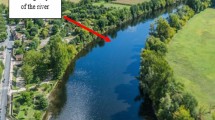Abstract
The construction of wading piers can modify the water flow characteristics of the river, and the quantity of piers is one of the significant influencing factors. Development of numerical simulation study of various numbers of piers on river flow patterns has significant and profound relevance to river flooding and river stability. A GIS-based Mike21 hydrodynamic model of the lower Yellow River is constructed and applied to the two-dimensional hydrodynamic numerical simulation of the lower Yellow River cross-river bridge section. The effect of the number of bridge piers on the flow regime at different flows is studied, and the mechanisms of changes in flow field, congestion height, and velocity are analyzed. The results suggested that with the growth of the number of piers, the congestion height in front of the bridge increased, but the increase gradually decreased, dropping by 2.22% overall. The average flow rate in front of the bridge has declined, with a gradual reduction of 2.01%. The range of flow field changes gradually expanded; however, the speed of increase in the influence range reduced by 11.85%.








Similar content being viewed by others
Data Availability
Data cannot be made publicly available; readers should contact the corresponding author for details.
References
Ahn J, Na Y, Park SW (2019) Development of two-dimensional inundation modelling process using MIKE21 model. KSCE J Civ Eng 23(9):3968–3977
Bates PD, Horritt MS, Hervouet JM (2015) Investigating two-dimensional, finite element predictions of floodplain inundation using fractal generated topography. Hydrol Process 12(8):1257–1277
Chang D, Chen X (2017) Comparative analysis of calculation results of river backwater under different pier generalization methods based on MIKE21 two-dimensional numerical simulation. Water Conservancy Sci Technol Econ 23(02):29–32
Feng P (2021) Risk assessment of urban floods based on a SWMM-MIKE21-coupled model using GF-2 data. Remote Sens 13, https://doi.org/10.3390/rs13214381
Guan M, Li Q, Zhu J et al (2019) A method of establishing an instantaneous water level model for tide correction. Ocean Eng 171:324–331
Hassan O, Morgan K, Probert EJ (2015) Unstructured tetrahedral mesh generation for three-dimensional viscous flows. Int J Numer Meth Eng 39(4):549–567
Hunt J, Brunner GW, Larock BE (1997) Flow transitions in bridge backwater analysis. J Hydraul Eng 125(9):981–983
Ji Z, Zhang F, Sun Y (2013) Numerical simulation of two-dimensional water flow at the bridge crossing in the plain river network area. Eng J Heilongjiang Univ 4(01):17–21
Liu X, Geng P, Cao L, Sun X (2020) Mike21 simulates the influence of cross-river bridges on river regimes. People’s Yellow River 42(S1):24–25+29
Luigia B, Martha KW (2013) Uncertainty in the estimation of backwater effects at bridge crossings. Hydrol Process 27(9):1292–1300
Pappenberger F, Matgen P, Beven KJ (2006) Influence of uncertain boundary conditions and model structure on flood inundation predictions. Adv Water Resour 29(10):1430–1449
Ren M, Xu Z, Su G (2017) Calculation and comparative analysis of bridge backwater based on two-dimensional hydrodynamic model and empirical formula. J Hydroelectr Eng 36(05):78–87
Selahattin K (2014) Prediction of backwater profiles due to bridges in a compound channel using CFD. Adv Mech Eng 6:905217
Sun D, Jin G, Li X, Chen J (2009) Study on the application of MIKE21 in flood routing of the lower Yellow River. People’s Yellow River 31(11):27–28
Ti Z, Zhang M, Li Y et al (2019) Numerical study on the stochastic response of a long-span sea-crossing bridge subjected to extreme nonlinear wave loads. Eng Struct 196(OCT.1):109287.1-1092871.3
Wang L (2007) One-dimensional and two-dimensional numerical simulation of rivers with MIKE. Dalian University of Technology
Wang G (2016) Research on the application of two-dimensional hydrodynamic model in the flood control impact assessment of Laohahe railway bridge. Jilin University 2016(9):96
Wang Q, Peng W, Dong F, Liu X, Ou N (2020) Simulating flow of an urban river course with complex cross sections based on the MIKE21 FM model. Water 12(3):761
Xu T (2010) Summary and application examples of Denmark MIKE21 model. Water Conservancy Sci Technol Econ 16(08):867–869
Xiong H, Chen L, Sun Z (2021) The impacts of piers on oil spill transport in a typical reach of the Middle Yangtze River. Water Sci Technol Water Supply. https://doi.org/10.2166/ws.2021.080
Yang L, Li J, Kang A et al (2020) The effect of nonstationarity in rainfall on urban flooding based on coupling SWMM and MIKE21. Water Resour Manag 34:1–17
Yuan X, Xu D (2006) Study on the application of Denmark’s MIKE21 model in the calculation of bridge crossing backwater. People’s Yangtze River 04:31–32+52
Zhang X, Wang T, Lu X (2021) Influence of bridge piers shapes on the flow of the lower Yellow River. Water Pract Technol 16(2):661–680
Zuo J, Zhang HX, Deng S et al (2020) Analysis of influence of mesh partition on Mike21 calculation in flood impact assessment. IOP Conf Ser: Earth Environ Sci 612(1):012060 (7pp)
Acknowledgements
The authors wish to thank the Key Scientific Research Project of Colleges and Universities in Henan Province (CN) [grant numbers 17A570004] for the collection, analysis and interpretation of data.
Author information
Authors and Affiliations
Corresponding authors
Ethics declarations
Competing interests
The authors declare no competing interests.
Additional information
Responsible Editor: Broder J. Merkel
Rights and permissions
Springer Nature or its licensor (e.g. a society or other partner) holds exclusive rights to this article under a publishing agreement with the author(s) or other rightsholder(s); author self-archiving of the accepted manuscript version of this article is solely governed by the terms of such publishing agreement and applicable law.
About this article
Cite this article
Zhang, X., Lu, Y., Wu, X. et al. Simulation study on the influence of the number of bridge piers on the flow regime of the lower Yellow River. Arab J Geosci 16, 115 (2023). https://doi.org/10.1007/s12517-023-11197-4
Received:
Accepted:
Published:
DOI: https://doi.org/10.1007/s12517-023-11197-4




